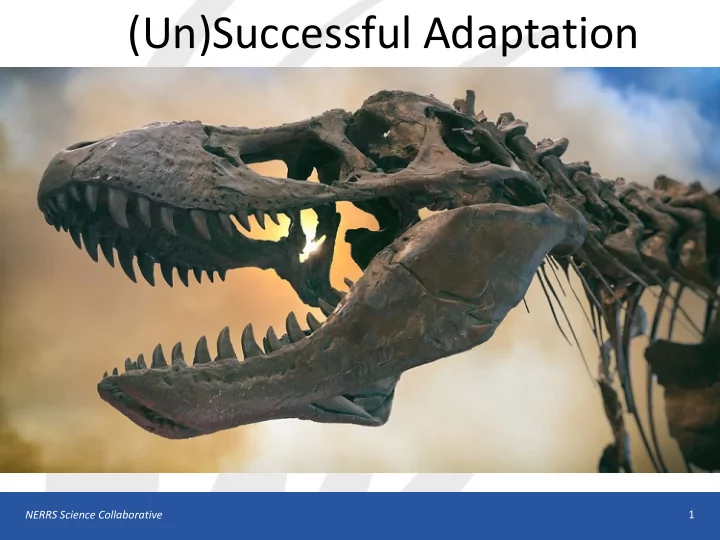

(Un)Successful Adaptation NERRS Science Collaborative 1
Welcome Enjoy your lunch and dive right in! What does “successful adaptation” mean to you? In your work? NERRS Science Collaborative 2
Fourth National Adaptation Forum • Madison, WI • April 24, 2019 Project Introduction: Successful Adaptation Indicators & Metrics Susi Moser, Ph.D. James Arnott, Dani Boudreau, Kristin Goodrich, Annie Cox, Syverine Bentz NERRS Science Collaborative
The SAIM Team Lisa Auermuller, Susi Moser & Jacques James Arnott Dani Boudreau & Cousteau Syverine Bentz & Chris Feurt NERRS Science Jessica Shepherd, Kristen Goodrich & Annie Cox, Collaborative Betsy Blair Kachemak Bay Tijuana River Wells technical support & Emilie Hauser, on Catalyst Hudson project NERRS Science Collaborative
What Is the Problem We’re Addressing? Sea is rising What to do? What to plan for? Is it the right thing? When to act? Is it working? NERRS Science Collaborative 5
SAIM Project Goals 1. Overarching NERRS-focused objective: Help reserves – Define “success” for their own purposes – Develop useful, impactful metrics to track progress (along adaptation pathway) – Learn from each other (through a multiple-site, comparative approach) 2. Overarching broader objective: Contribute to scientific and policy debates – Share lessons with regional partners, other reserves, coastal scientists and managers faced with similar challenges – Contribute to national indicator system – Contribute to broader “M&E” discussion in the adaptation community NERRS Science Collaborative
Progress to Date • 3 webinars specifically focused on SAIM project for NERRS • 6 workshops across 5 partnering reserves • 5+ semi-annual survey/check-ins with cohorts + annual meeting interaction (incl. professional sharing) • 1 peer-reviewed publication (2 nd in progress) • Several presentations to interested parties beyond NEERS – USDN (May 2015) – Community Resilience Panel (April 2016) – National Academy of Science (December 2016) – American Society of Adaptation Professionals (April 2017) – National Socioenvironmental Synthesis Center (Aug 2017) – Social Coast Forum (February 2018) – Restore America’s Estuaries (2018) NERRS Science Collaborative
Toolkit Development • Tijuana River NERR – lead – Project management – Collaboration • 3 additional partner reserves on project team • Susi & James – technical support, partners in implementation NERRS Science Collaborative 8
Sharing What We Learned Systemwide …and Beyond • NERRS Science Collaborative Key: • Reserves participating in SAIM project and toolkit • Reserve involved in SAIM project
The Successful Indicators and Metrics Toolkit (and Community of Practice) • Focus : Coastal areas actively working on climate change adaptation but intended for broader audience • Audiences : – Reserve programs and other coastal managers – Adaptation professionals and their partners • Goals : 1. Integrate learning from project to date 2. Share facilitation tools and resources systemwide and beyond 3. Build capacity around identifying, selecting, tracking and using SAIMs NERRS Science Collaborative 10
Input in Toolkit Design • Elicitations ongoing – Professional Sharing Sessions with NERRS (2016, 2017, 2018) – Social Coast Forum 2018 – NERRS SC Advisory Board – RAE 2018 – NAF 2019 - TODAY!! Photo: Susi Moser NERRS Science Collaborative 11
SAIM Toolkit: Initial Content Ideas Introduction and • motivation to develop SAIMs Indicator development in • 4. Using 1. Exploring larger context of indicators indicators adaptation planning Facilitation tools for • different stages in process Lessons learned • Sample indicators • 3. Tracking 2. Selecting indicators indicators Readings & Resources • Opportunity to enter and • track data over time NERRS Science Collaborative 12
Getting There… • Workshops at various conferences to shape and test toolkit • Development of two-way interactive website – Close collaboration with NOAA OCM, Digital Coast, and SWMP Data Management • Trainings on tools in toolkit • Building an initial community of practice to sustain NERRS Science Collaborative 13
Clarifying Questions? NERRS Science Collaborative 14
Table Conversations: A Bit of Give and Take How do you think about • successful adaptation? What resources have you • found helpful? What would be helpful • to you – resources, tools, job aids, entry points? NERRS Science Collaborative 15
Next Steps • Processing input to determine toolkit design • Website development • Gathering, development of tools and resources • Trainings • Toolkit refinement • Additions over time NERRS Science Collaborative 16
Thank you! Susi Moser, Ph.D. Susanne Moser Research & Consulting Email: promundi@susannemoser.com Web: www.susannemoser.com Dani Boudreau Tijuana River NERR Email: dboudreau@trnerr.org Project website http://graham.umich.edu/water/nerrs/resources/cli mate Thank you to our funder, the NERRS Science Collaborative! NERRS Science Collaborative
Recommend
More recommend